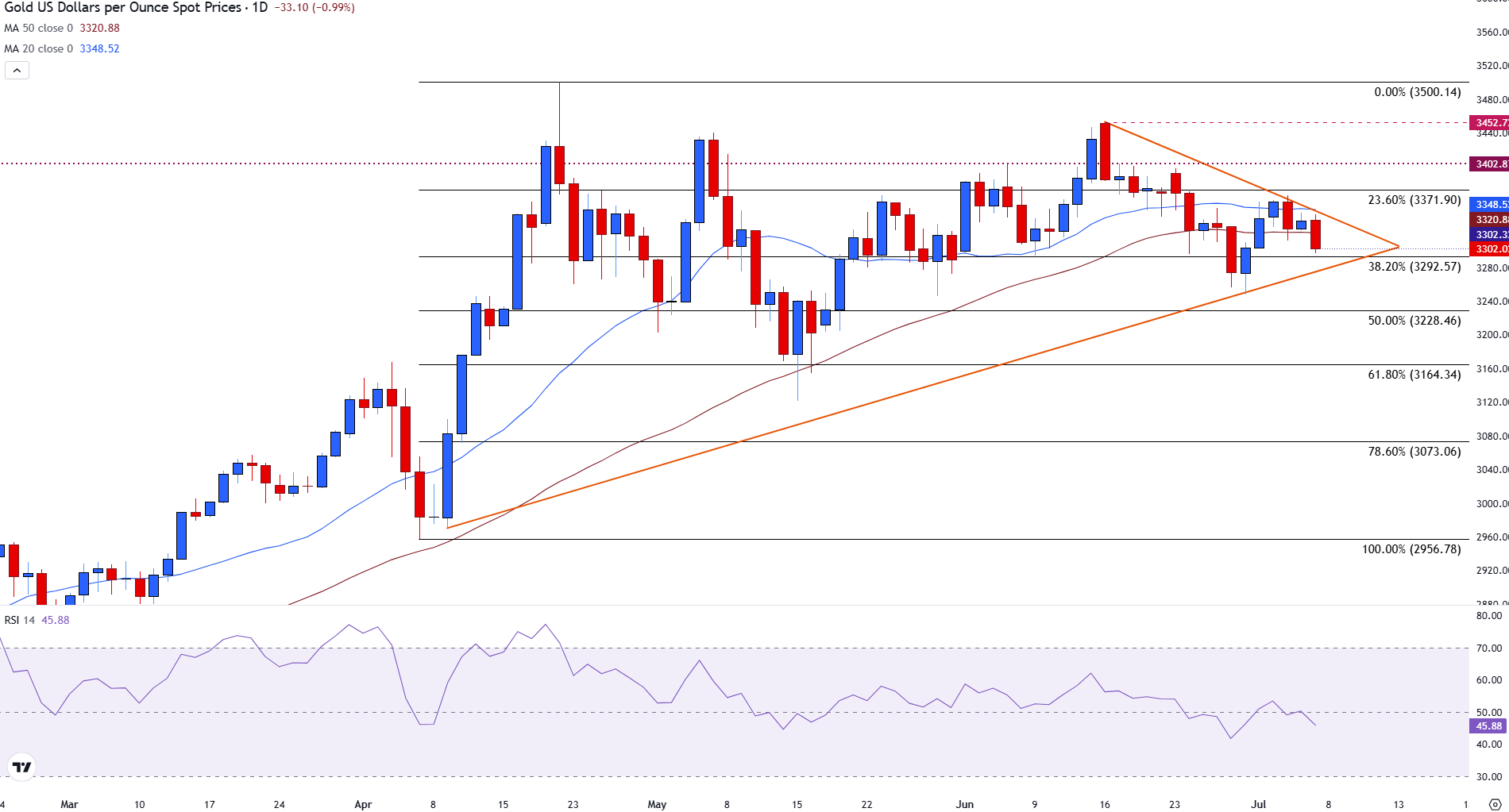Created
: 2025.07.07














![]() 2025.07.07 21:04
2025.07.07 21:04
Gold (XAU/USD) is currently under pressure as markets await more news of trade deals ahead of Wednesday's tariff deadline.
In the European session, Gold is trading around $3,300 at the time of writing.
Liquidity and trade volumes are increasing on Monday as the US returns to financial markets following Friday's Independence Day holiday.
US yields have also firmed after Thursday's Nonfarm Payrolls (NFP) report revealed a resilient labour market. This reduced the prospects that the Federal Reserve (Fed) would lower interest rates in July. The positive economic data has eased fears of a slowing economy, lifting the US Dollar.
Expectations that interest rates will remain at higher levels for longer do not bode well for non-yielding assets such as bullion.
The current daily chart of Gold shows price action consolidating within a symmetrical triangle, suggesting that a breakout is likely as the range narrows. This tightening formation reflects growing pressure, which often precedes a significant directional move.
Recently, XAU/USD dropped below both the 20-day Simple Moving Average at $3,348 and the 50-day SMA at $3,320. The price is also approaching the 38.2% Fibonacci retracement level at $3,292, a critical support zone that will help determine the near-term direction.
If the latter fails, downside targets include the 50% and 61.8% Fibonacci retracement levels at $3,228 and $3,164, respectively.
Spot Gold (XAU/USD) daily chart

However, if the price manages to hold above $3,300 and rebound, a bullish reversal could occur. In that case, the first upside targets would be reclaiming the 50-day SMA and then the 20-day SMA. A confirmed breakout above the triangle resistance and the 23.6% Fibonacci level at $3,371 would open the door for further gains, with a potential move toward psychological resistance at $3,400.
The Relative Strength Index (RSI) sits near 45, reflecting mild bearish momentum but with room enough before going into oversold territory.
Gold has played a key role in human's history as it has been widely used as a store of value and medium of exchange. Currently, apart from its shine and usage for jewelry, the precious metal is widely seen as a safe-haven asset, meaning that it is considered a good investment during turbulent times. Gold is also widely seen as a hedge against inflation and against depreciating currencies as it doesn't rely on any specific issuer or government.
Central banks are the biggest Gold holders. In their aim to support their currencies in turbulent times, central banks tend to diversify their reserves and buy Gold to improve the perceived strength of the economy and the currency. High Gold reserves can be a source of trust for a country's solvency. Central banks added 1,136 tonnes of Gold worth around $70 billion to their reserves in 2022, according to data from the World Gold Council. This is the highest yearly purchase since records began. Central banks from emerging economies such as China, India and Turkey are quickly increasing their Gold reserves.
Gold has an inverse correlation with the US Dollar and US Treasuries, which are both major reserve and safe-haven assets. When the Dollar depreciates, Gold tends to rise, enabling investors and central banks to diversify their assets in turbulent times. Gold is also inversely correlated with risk assets. A rally in the stock market tends to weaken Gold price, while sell-offs in riskier markets tend to favor the precious metal.
The price can move due to a wide range of factors. Geopolitical instability or fears of a deep recession can quickly make Gold price escalate due to its safe-haven status. As a yield-less asset, Gold tends to rise with lower interest rates, while higher cost of money usually weighs down on the yellow metal. Still, most moves depend on how the US Dollar (USD) behaves as the asset is priced in dollars (XAU/USD). A strong Dollar tends to keep the price of Gold controlled, whereas a weaker Dollar is likely to push Gold prices up.
![]()
Created
: 2025.07.07
![]()
Last updated
: 2025.07.07

FXStreet is a forex information website, delivering market analysis and news articles 24/7.
It features a number of articles contributed by well-known analysts, in addition to the ones by its editorial team.
Founded in 2000 by Francesc Riverola, a Spanish economist, it has grown to become a world-renowned information website.
We hope you find this article useful. Any comments or suggestions will be greatly appreciated.
We are also looking for writers with extensive experience in forex and crypto to join us.
please contact us at [email protected].
Disclaimer:
All information and content provided on this website is provided for informational purposes only and is not intended to solicit any investment. Although all efforts are made in order to ensure that the information is correct, no guarantee is provided for the accuracy of any content on this website. Any decision made shall be the responsibility of the investor and Myforex does not take any responsibility whatsoever regarding the use of any information provided herein.
The content provided on this website belongs to Myforex and, where stated, the relevant licensors. All rights are reserved by Myforex and the relevant licensors, and no content of this website, whether in full or in part, shall be copied or displayed elsewhere without the explicit written permission of the relevant copyright holder. If you wish to use any part of the content provided on this website, please ensure that you contact Myforex.
Myforex uses cookies to improve the convenience and functionality of this website. This website may include cookies not only by us but also by third parties (advertisers, log analysts, etc.) for the purpose of tracking the activities of users. Cookie policy